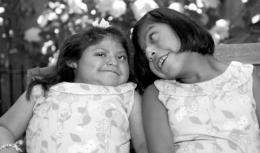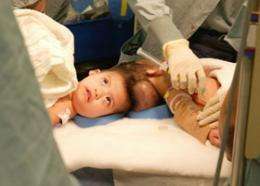Nine years later, twins lead separate but unequal lives

They were called "Las Dos Marias," the two Marias, playful 11-month-old twins from Guatemala who were born joined at the head. Nine years after a 23-hour operation at UCLA freed them to live their own lives, they are no longer patients here. But the two surgeons who so famously separated them are still tenuously tethered to the girls.
The two surgeons, Dr. Jorge Lazareff and Dr. Henry Kawamoto Jr., along with UCLA anesthesiologist Dr. Van De Wiele, joined celebrants at the girls’ lavish, luau-themed 10th birthday party last Saturday at a private home in Malibu, hosted by Mending Kids International, the organization that now supports the twins’ care and helps thousands of children from developing countries receive corrective surgeries.
Throughout the last nine years, both surgeons have attended birthday parties for the twins, who now live with host families in Southern California. They have watched the twins move in very different directions.
The twin who was smaller as an 11-month-old, Maria de Jesus (now called Josie), will enter the fourth grade at a local public school this fall. She loves playing with friends and performs with a synchronized swim team, but needs assistance to walk. Her less fortunate sister, Maria Teresa, nicknamed Teresita, suffered brain damage as a result of contracting meningitis in 2003 in Guatemala. She does not walk or speak, although she manages to communicate non-verbally with those closest to her.
While the two girls are being raised in Southern California, their parents, Alba Leticia Alvarez and Wenceslao Quiej Lopez, visit a couple of times a year. Within four months of their return to Guatemala, "It became apparent that their fragile medical conditions were too challenging for their family and physicians in Guatemala to handle," said officials with Mending Kids International in a statement. "They were quickly returned to the United States to be treated and it became imperative for the well-being of the girls to live close to the necessary medical facilities in the United States."
The outcomes have left those so intricately involved in that landmark operation performed at Mattel Children’s Hospital with a bittersweet aftertaste.
"It’s sad about her sister," said Kawamoto, a plastic and reconstructive surgeon who operated on the twins along with Dr. Jorge Lazareff, director of pediatric neurosurgery at UCLA. "But it could have happened to anybody." Kawamoto said he believes the meningitis was not attributable to the medical care they received in Guatemala. "It was the bad luck of the draw."

"Do we wish that some aspects of their health outcome had been better? Yes, but are we aware that some aspects could have been much worse? Again, yes. So then we are happy with what was achieved. When they left UCLA in January of 2004, I sincerely believed that they both would have an independent life. But the meningitis was a big setback for Maria Teresa. Now I fear that only one of the twins will have a fully independent life. But you just never know."
Although they both have done surgeries as complex as this one since their most celebrated feat, both physicians said they will always remember the exemplary teamwork demonstrated by the more than 50 people who played a role, according to a very detailed plan.
"I carry the memory of the people who kept the ward clean for 24 hours … the people who carried blood from the blood bank to the OR … the nurses who worked so hard, although nobody now remembers their names," Lazareff said. "And I remember that wonderful warm feeling that was so prevalent in those days."
Dr. Kawamoto still recalls the meticulous planning that went into every step in the months-long process of separating the skulls of the conjoined twins. "It was planned and planned and planned. It was pretty remarkable how everybody just pitched in and did their job.
"I always said I now know how a conductor of a large orchestra feels when every musician hits the right note at the right time," he said. "The joy in that symphonic movement of the operation was the most pleasing thing to me."
Kawamoto recalled that there was only one moment when he felt nervous during the marathon surgery. And that happened when he made the first incision. "I realized as I had the scalpel in my hand that if our planning was somehow wrong, the twins would die." Once he got past that, the nervousness melted away. "We were already down that road," he recalled.
For Lazareff, one unexpected outcome of the twins’ operation was the international recognition it has brought him. That has helped smooth the way for him to work with hospitals and doctors in foreign countries like China and Nicaragua in an effort to help raise their skill level, but with professional respect and on equal footing.
Since the surgery, Lazareff has spent years traveling to developing countries to work shoulder to shoulder with local doctors and then to bring them to UCLA to train and learn new techniques.
When he used to call to try and establish a relationship with a hospital in a foreign land, people would not respond right away. Now, he said, "They say, ‘Ah, you’re the guy with the twins. Ok, what do you want?’"

















